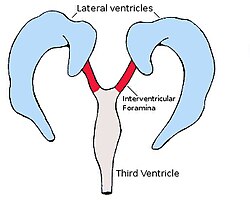Interventricular foramina (neuroanatomy)
| Interventricular foramina | |
|---|---|
 The lateral ventricles connected to the third ventricle by the interventricular foramina. | |
 Cerebrospinal fluid is present in spaces in and around the brain. | |
| Details | |
| Part of | Ventricular system |
| Identifiers | |
| Latin | foramen interventriculare, foramen Monroi |
| NeuroNames | 447 |
| TA98 | A14.1.08.411 |
| TA2 | 5641 |
| FMA | 75351 |
| Anatomical terms of neuroanatomy | |
In the
Structure
The interventricular foramina are two holes (
Development
The development and shape of the ventricular system relates to the differential development of different parts of the brain, with the ventricular system ultimately arising from the neural tube.[3] The lateral ventricles remain connected to the third ventricle throughout development, themselves developing as outpouchings from the third ventricle.[3] The foramina develop slowly in a forward and outward direction as the fornix grows in size.[3][4]
Function
The interventricular foramina connect the
The walls of the interventricular foramina contain choroid plexus, a specialized structure that produces cerebrospinal fluid. The choroid plexus of the third ventricles continues through the foramina into the lateral ventricles.[5]
End branches of the
Clinical significance
The interventricular foramina give rise to disease when they are narrowed or blocked.
The most common symptom of blockage is
History
The foramina were named after the
In this publication, Monro notes that the ventricular system has been noted to be connected, implying the presence of the foramen, since the time of the physician anatomist Galen.[3] Monro described it as:
... an oval hole, large enough to admit a goose quill, under forepart of the fornix. From this hole, a probe can be readily passed into the other lateral ventricle, shewing [sic], in the first place that the two lateral ventricles communicate with each other[8]
Monro's original description, of two lateral ventricles joined by a foramen that then joined the third ventricle, is in fact incorrect.[7][8] As noted by Monro himself, previous authors have also described the ventricles as having connections; consequently, the eponym of "Monro" has been disputed.[8]
References
- ^ a b Gray's Anatomy 2008, p. 237.
- ^ Gray's Anatomy 2008, p. 287.
- ^ PMID 25079886.
- ^ Gray's Anatomy 2008, p. 383.
- ^ Gray's Anatomy 2008, p. 242.
- ^ PMID 21532385.
- ^ PMID 22482794.
- ^ PMID 16562219.
- Books
- Susan Standring; Neil R. Borley; et al., eds. (2008). Gray's anatomy : the anatomical basis of clinical practice (40th ed.). London: Churchill Livingstone. ISBN 978-0-8089-2371-8.
External links
- doctor/941 at Who Named It?
- "Anatomy diagram: 13048.000-3". Roche Lexicon – illustrated navigator. Elsevier. Archived from the original on 22 July 2012.
